
The City Loop is a piece of underground commuter rail infrastructure in the central business district (CBD) of Melbourne, Victoria, Australia.

Transit police are specialized police agencies employed either by a common carrier or a municipality, county, district, or state. Transit law enforcement services may also be provided by a specialized unit within a larger local law enforcement agency. Their mandate is to prevent and investigate all crime committed against the carrier or its passengers, as well as crime incidentally committed on – and sometimes around – the carrier's property.
Mass Rapid Transit Authority of Thailand or MRTA is a state enterprise under the Ministry of Transport of Thailand. It is responsible the operation of rapid transit systems in the Bangkok Metropolitan Region and including other provinces as defined by the royal decree. The MRTA was founded in 1992 and underwent restructuring in 2000. The MRTA currently oversees the operation of the MRT, which consists of the operational Blue Line, Purple Line and Yellow Line. Other systems, including the Airport Rail Link, are owned and operated by other agencies.
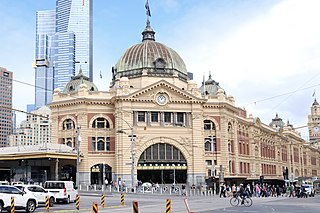
The Melbourne rail network is a passenger and freight train system in the city of Melbourne, Victoria, Australia. The metropolitan passenger rail network is centred on the Melbourne CBD and consists of 222 stations across 16 lines, which served a ridership of 99.5 million over the year 2021–2022. It is the core of the larger Victorian railway network, with links to both intrastate and interstate systems.
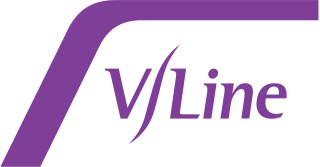
V/Line is a statutory authority that operates regional passenger train and coach services in Victoria, Australia. It provides passenger train services on five commuter lines and eight long-distance routes from its major hub at Southern Cross railway station in Melbourne. It also provides bus services across Victoria and into New South Wales, the Australian Capital Territory and South Australia. In addition, V/Line is responsible for the maintenance of much of the Victorian freight and passenger rail network outside of the areas managed by Metro Trains Melbourne and the Australian Rail Track Corporation.
The State Rail Authority, a former statutory authority of the Government of New South Wales, operated and maintained railways in the Australian state of New South Wales from July 1980 until December 2003.

The Victorian Railways (VR), trading from 1974 as VicRail, was the state-owned operator of most rail transport in the Australian state of Victoria from 1859 to 1983. The first railways in Victoria were private companies, but when these companies failed or defaulted, the Victorian Railways was established to take over their operations. Most of the lines operated by the Victorian Railways were of 5 ft 3 in. However, the railways also operated up to five 2 ft 6 in narrow gauge lines between 1898 and 1962, and a 4 ft 8+1⁄2 instandard gauge line between Albury and Melbourne from 1961.

The State Transit Authority of New South Wales, also referred to as State Transit, was an agency of the Government of New South Wales operating bus services in Sydney. Superseding the Urban Transit Authority in 1989, it was also responsible for the provision of ferry services in Sydney until 2004 and bus and ferry services in Newcastle until 2017. It ceased trading after 2 April 2022 with its remaining operations to be contracted out by Transport for NSW to replacement operators.
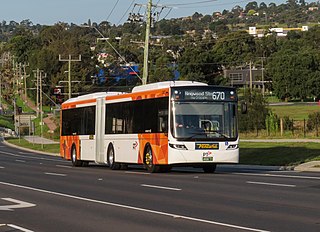
Buses in Melbourne, Australia, are a major form of public transport in Melbourne, with an extensive bus network. There are 346 routes in operation with a varying range of service frequencies, operated by privately owned bus companies under franchise from the State Government. The Night Network bus system consists of 10 routes and operates on Friday and Saturday nights, and a SmartBus orbital bus network currently consisting of nine routes, which is intended to facilitate cross city travel, while the current network is predominantly a radial network. Most of the bus network is a covered by the myki ticketing system.
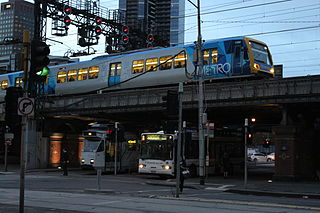
Transport in Melbourne, the state capital of Victoria, Australia, consists of several interlinking modes. Melbourne is a hub for intercity, intracity and regional travel. Road-based transport accounts for most trips across many parts of the city, facilitated by Australia's largest freeway network. Public transport, including the world's largest tram network, trains and buses, also forms a key part of the transport system. Other dominant modes include walking, cycling and commercial-passenger vehicle services such as taxis.
VicRoads is a government joint venture in the state of Victoria, Australia. In the state, it is responsible for driver licensing and vehicle registration. It is owned and operated through a joint venture between the Victorian government and a consortium made up of Aware Super, Australian Retirement Trust and Macquarie Asset Management.

The Melbourne & Metropolitan Tramways Board (MMTB) was a government-owned authority that was responsible for the tram network in Melbourne, Australia between 1919 and 1983, when it was merged into the Metropolitan Transit Authority. It had been formed by the merger of a number of smaller tramway trusts and companies that operated throughout the city.
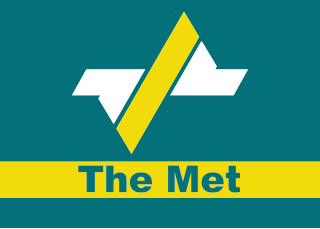
The Public Transport Corporation (PTC) was a Victoria State Government owned statutory authority formed under the Transport Act 1983 which operated passenger and freight trains, trams and bus services.

The Country Roads Board was a government authority responsible for the construction and maintenance of main roads in the state of Victoria, Australia between 1913 and 1983.

The Metropolitan Transit Authority (MTA), known to the general public as The Met, was a Government of Victoria owned corporate body that operated suburban passenger trains, trams and buses in Victoria, Australia. It was set up under Section 15 of the Transport Act 1983 and commenced operation on 1 July 1983. It was a statutory body set up to manage the trams formerly operated by the Melbourne & Metropolitan Tramways Board, the metropolitan train operations of the former VicRail, and the operations of the former Melbourne Underground Rail Loop Authority.

Transperth is the public transport system for Perth and surrounding areas in Western Australia. It is managed by the Public Transport Authority (PTA), a state government organisation, and consists of train, bus and ferry services. Bus operations are contracted out to Swan Transit, Path Transit and Transdev. Ferry operations are contracted out to Captain Cook Cruises. Train operations are done by the PTA through their Transperth Train Operations division.

The Director of Public Transport was the head of the Public Transport Division (PTD) of the Victorian Department of Transport. PTD was the government agency responsible for promoting, providing, coordinating and regulating public transport in the state of Victoria, Australia between August 1999 and June 2013. The Director of Public Transport was created as a statutory office supported by staff of the Department of Transport.
Public Transport Victoria (PTV) is the brand name for public transport in the Australian state of Victoria. It was the trading name of the Public Transport Development Authority (PTDA), a now-defunct statutory authority in Victoria, responsible for providing, coordinating, and promoting public transport.
The Transport Act 1983 was the main statute establishing government transport organisations and regulating land transport activities in the State of Victoria, Australia for 27 years from mid-1983 to mid-2010. The Act was used as the vehicle for changes to transport organisational arrangements and transport regulation activities pursued by Victorian governments over that period.
The Ministry of Transport, later known as the Department of Transport, was a statutory ministry that acted as the chief transport agency of the Government of Victoria between 1958 and 1996. Originally established by the Transport Act 1951 and strengthened by the Transport Act 1983, the Ministry took on a variety of roles, coordinating the state's other transport operations and reporting to a number of Ministers throughout its history.














